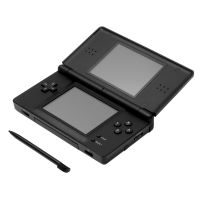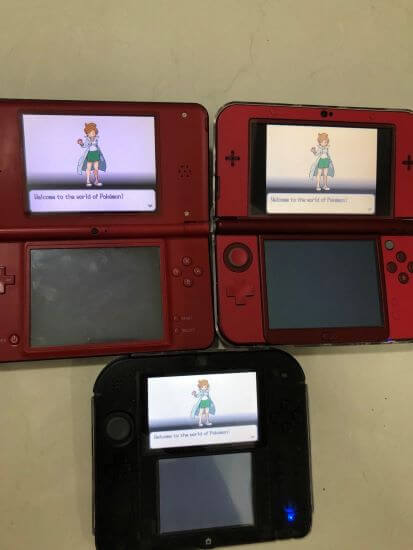I don’t intend to write a Nintendo DS review, because my Nintendo DS Lite is only for dumping GBA cartridges. As a result, I used to DS games on my Nintendo 2DS or New Nintendo 3DS XL, which I also wrote a very long Nintendo 3DS review to guide you which one to choose. But hearing a lot about how different when you compare DS games on Nintendo DSi XL vs 3DS, I finally decided to give it a shot. The result, I use my Nintendo DSi XL mainly for playing DS games from now on.
Too long didn’t read: I still recommend you to get one in Nintendo 3DS family, if you truly want one handheld to handle the most game systems. But if you truly love DS system (which is currently the most sold handheld family), you should get a Nintendo DS for the most accurate experience.
Sections

Slim Nintendo DS that is great for playing GBA and NDS
The Nintendo DS Lite isn’t the best performer in DS family, but it is an iconic Nintendo DS with its own DS symbol. It can play both GBA and NDS cartridges, and if you want the most lightweight, pocketable Nintendo DS, this is what you should buy.
*DISCLAIMER: This site contains affiliate links for which I may be compensated, and as an eBay Partner, I may be compensated if you make a purchase.
Nintendo DS family alone has been sold for more than 150 million units, one number that the Nintendo Switch is restlessly trying to match. This is also the best-selling handheld device in the gaming history, one thing that every gamer should at least own one.
Nintendo DS Review: Price
- MSRP: $149
- Different price for different model across the family
Though the introductory price of the Nintendo DS is $149 at first, it’s quickly reduced to only $129. The Nintendo DSi that comes later in the DS family’s life has an increased price of $160, which is reasonable because it has upgraded internal hardware.
Just like the Nintendo 3DS, the nature of having dual-screen in the Nintendo DS made it very hard to get an accurate system experience by using other retro handheld emulators. As a result, you need to combine two screens into one if you want to try an emulator, and I find such experience really bad.
However, if you are not into the huge Nintendo DS games library, the emulators can do a very good job at quick save states and load states. They help reduce the base difficulty of many games, which is quite suitable for people with heavy adult lives. But, paying for a very lackluster experience in handheld emulators should cost you at least $170 for a 4-inch screen. Anywhere below is just too horrendous to say.
If you have a Nintendo 3DS, you can easily run Nintendo DS cartridges, or dumping them for easier navigation using Twilight Menu++ – a homebrewed application to run nds files. The experience is really great, as you can stretch DS games to fit the screen of a 3DS, or you can upgrade the audio quality. Still, many people believe that the Nintendo DSi XL is the best way to enjoy a nds game, and I will explain soon enough.
Related post: Best handheld gaming console.
Nintendo DS Review: Design and Build Quality
| Features | Nintendo DS Fat | Nintendo DS Lite | Nintendo DSi | Nintendo DSi XL |
|---|---|---|---|---|
| Console |  |  |  |  |
| Dimensions | 148.7 mm x 84.7 mm x 28.9 mm (closed) | 133 mm x 73.9 mm x 21.5 mm (closed) | 137 mm x 74.9 mm x 18.9 mm (closed) | 161 mm x 91.4 mm x 21.2 mm (closed) |
| Weight | 275 grams | 218 grams | 214 grams | 314 grams |
| Form | Horizontal | Horizontal | Horizontal | Horizontal |
| Upper Screen | 3 inch TFT, 256 x 192, 106.7 PPI, 4:3 aspect ratio | 3.12 inch TFT, 256 x 192, 102.6 PPI, 4:3 aspect ratio | 3.25 inch TFT, 256 x 192, 98.5 PPI, 4:3 aspect ratio | 4.2 inch IPS, 256 x 192, 76.2 PPI, 15:9 aspect ratio |
| Lower Screen | 3 inch TFT, 256 x 192, 106.7 PPI, 4:3 aspect ratio | 3.12 inch TFT, 256 x 192, 102.6 PPI, 4:3 aspect ratio | 3.25 inch TFT, 256 x 192, 98.5 PPI, 4:3 aspect ratio | 4.2 inch IPS, 256 x 192, 76.2 PPI, 15:9 aspect ratio |
| Colors | Black, White, Turquoise Blue, Blue, Pink and Titanium | Black, White, Turquoise Blue, Blue, Pink and limited editions | Black, White, Turquoise Blue, Blue, Pink and limited editions | Black, White, Blue, Burgundy, Yellow and limited editions |
| Speaker placement | Front facing, top | Front facing, top | Front facing, top | Front facing, top |
| Storage | Cartridge save | Cartridge save | External SD card | External SD card |
| Audio output | 3.5mm headphone jack | 3.5mm headphone jack | 3.5mm headphone jack | 3.5mm headphone jack |
| Video output | ✗ | ✗ | ✗ | ✗ |
| Charge port | Proprietary | Proprietary | Proprietary | Proprietary |
Nintendo DS Fat
The original Nintendo DS handheld (commonly called as the Nintendo DS Fat) was only produced for 3 years before it is completely replaced by the next Nintendo DS Lite. Therefore, it’s super difficult to get one original Nintendo DS in mint conditions.
Unless you want to collect a system to show off, the Nintendo DS Fat can’t be compared with the Nintendo DS Lite. It is bigger, heavier but the screen is smaller and more issues than other DS members. As a result, I find a lot original Nintendo DS devices to have lines across the screen.
Still, there is one reason to choose the DS fat over the DS lite: its clicky buttons, which are much more suitable to my fingers than the mushy buttons in the DS lite. Honestly, I don’t use my Nintendo DS Lite much because of these buttons. Many people will find the design more suitable for their hands, and that’s so subjective.
There is a popular 3.5 mm headphone jack in the Nintendo DS, in contrary to the Game Boy Advance SP that you need an adapter to provide stereo audio. Talking about stereo speakers, the Nintendo DS implements stereo audio through speakers located on either side of the upper display screen. It is a massive upgrade from the Game Boy Advance which has only mono speaker.
The original Nintendo DS uses the same charger that you used with the Game Boy Advance SP, so if you use both system, you don’t need to get an additional charger. That’s quite an advantage for the Nintendo DS Fat when compared to the Nintendo DS Lite.
However, I don’t really like the build quality of this system. It is not as sturdy as the Nintendo DS Lite, which is quite sarcastic considered its chunky build. It could be unit variation, but if you’re going to blind buy, I believe you should get the Nintendo DS Lite instead.
- Clicky buttons
- Uses the same proprietary port as the GBA SP
- Compatible with GBA games
- Small screens
- Build quality isn’t good, while being the bulkiest and heaviest in the family
- The oldest model, so it would have bad hinge or screen issues
Nintendo DS Lite
The Nintendo DS Lite is the slimmer update of the original Nintendo DS, which has been sold for 6 years from its release date. It is the best-selling device in its whole family, making its design to be copied in the next Nintendo DSi, and even in the Nintendo 3DS.
Its design is more sturdy than the original Nintendo DS, while smaller, slimmer and lighter. One thing that contributes to its highest sales is 45% of Nintendo DS owner is female, so they would like a slim product. As a result, the Nintendo DS Lite does a great job at trimming its size to what we know.
Other buttons placement and features of the Nintendo DS Lite remains the same. However, if you prefer tactile buttons over mushy ones, you should stay away from the Nintendo DS Lite. Actually I don’t use Nintendo DS Lite, but because I enjoy using C-Pad in the Nintendo 2DS as an alternative, and you know that the 2DS shares the same D-Pad feeling as the DS Lite.
Apart from the button feeling, it’s a clear win for the Nintendo DS Lite. It does everything the original Nintendo DS can do, in a much better form and size. The screen is slightly bigger, which is another reason to pick the DS Lite instead of the DS Fat. Even the included stylus is bigger, which is suitable for my taste than the original DS.
However,, I must remind you that you need a distinct charger for the DS Lite, because it doesn’t use the same proprietary port from DS Phat and Game Boy Advance SP. The new AC port is smaller than the previous models, and it isn’t the same one being used in the Nintendo DSi and the whole 3DS family. So, it is the only port of its kind, you can’t reuse it in any other devices.
- Bigger screen
- Slimmer and lighter
- Better build quality
- Better stylus
- Compatible with GBA games
- The oldest model, so it would have bad hinge or drifted C-Pad
- Unique proprietary port
Nintendo DSi
The Nintendo DSi is supposed to be the mid-life upgrade to the whole DS family, featuring new power and better features. However, considering the design, the DSi mimics the Nintendo DS Lite, while having larger screen and even slimmer design. It is quite impressive of how Nintendo can meet the consumer demand by reducing the size of the DS Lite even more.
So, the Nintendo DSi meets everything you want from the DS Lite, by sacrificing the GBA cartridge slot to improve portability without decreasing durability. At the time of the Nintendo DSi’s release, the DS games library is so huge that it doesn’t need to feature backward compatibility.
Imagine an even slimmer and lighter DS Lite, with larger screen; and you have the Nintendo DSi. For more, the Nintendo DSi features two digital cameras that supports a variety of DSiWare that can’t be used in previous DS models. It can’t be compared to the modern camera in your smartphone, but if you want to impress others with a retro handheld, the Nintendo DSi certainly show off its camera.
However, there are two things that I love from the Nintendo DSi over the Nintendo DS Lite. First, it has an external storage using the SD card, and you can dump DS games and store your games directly in your SD card. It could reduce the time when you need to switch games, and lower the chance your precious cartridges be damaged.
Second, the Nintendo DSi has the same clicky buttons from the DS Phat, and I prefer them over the mushy buttons in the DS Lite. It is just subjective, so if you don’t care much about which buttons to press, perhaps you should get the DS Lite for GBA compatibility and cheaper price.
- The same design, with larger screen and slimmer form
- Has external storage
- Has two digital cameras
- Clicky buttons
- Not compatible with Game Boy Advance
Nintendo DSi XL
The final member of the DS family is the Nintendo DSi XL, which is the ultimate DS system with bigger size, larger and better screens than anything prior to its release. It is nearly the same as the Nintendo 3DS XL, so you can expect a much larger device than the previous DSi. I feel the Nintendo DSi XL to have the best build quality of the all family, the same as how I feel from the New Nintendo 3DS XL. You can think of these handheld devices as the flagship of their own families.
However, the reason why people praising the Nintendo DSi XL as the best way to enjoy DS games is because of its dual IPS screens. In general, IPS screens offer better color production and wider view angle than TN panels, which are used in every previous DS model. Together with a 4.2-inch screen (which is larger than a 3DS screen), the Nintendo DSi XL shows off the best display for your DS games.
The display is even superior than a common New Nintendo 3DS XL with top IPS screen, because the Nintendo DSi XL displays DS games in true pixels, while the New Nintendo 3DS XL doesn’t. As a result, you will find DS games on the Nintendo DSi XL has overall better image quality than the 3DS system.

Other than that, we could think the Nintendo DSi XL as the same DSi in bigger form, with the same pros and cons.
- Bigger and better IPS screens
- The best build quality
- Has external storage
- Has two digital cameras
- Clicky buttons
- Not compatible with Game Boy Advance
Nintendo DS Review: Gaming Experience
| Features | Nintendo DS Fat | Nintendo DS Lite | Nintendo DSi | Nintendo DSi XL |
|---|---|---|---|---|
| Console |  |  |  |  |
| CPU | ARM9746E-S chip, single-core @ 67 MHz and ARM7TDMI chip, single-core @ 33 MHz | ARM9746E-S chip, single-core @ 67 MHz and ARM7TDMI chip, single-core @ 33 MHz | ARM 9 chip, single-core @ 133 MHz and ARM7TDMI chip, single-core @ 33 MHz | ARM 9 chip, single-core @ 133 MHz and ARM7TDMI chip, single-core @ 33 MHz |
| GPU | ✗ | ✗ | ✗ | ✗ |
| Memory | 4 MB PSRAM | 4 MB PSRAM | 16 MB RAM | 16 MB RAM |
| Battery | 850 mAh | 1000 mAh | 840 mAh | 1050 mAh |
| Connectivity | Built-in 802.11 Wi-Fi | Built-in 802.11 Wi-Fi | Built-in 802.11 Wi-Fi | Built-in 802.11 Wi-Fi |
| Cooling system | ✗ | ✗ | ✗ | ✗ |
Related post: Best retro handheld emulator.
Performance
- Pokemon White
- Pokemon Black 2
If you use the Nintendo DS family for DS games only, they will have the perfect performance without lagging and audio stuttering. Considering its cheap price for an used DS product, I believe this is the best way to enjoy a huge DS games library.
There are DSi-enhanced games that require a Nintendo DSi or Nintendo DSi XL to add more features, such as Pokemon White and Pokemon Black 2 that I used as tested games. Still, the difference are not important to bother getting a DSi for enjoying DS games, considering you’ve already owned a DS Lite for example.
By the way, there are many retro handheld emulators that can handle the Nintendo DS system pretty well. You must pay for at least the Anbernic RG353P for a decent DS experience, but a 3.5-inch screen that tries to stuff DS dual-screen, you can understand how bad it is.
Related post: Best handheld gaming PC.
Gaming session
Gaming session is incredible using a Nintendo DS, but if you prefer C-Pad than D-Pad, you should consider getting a Nintendo 3DS to run your DS games. Other than that, I don’t recommend using any single-screen retro handheld emulator to play nds games. You can’t enjoy the same experience, and I believe the battery life of all modern emulators is much more inferior than the DS system.
While I still tested nds games on common retro handheld devices, for example when I load nds games on Miyoo Mini Plus in curiosity, I find that you can’t replace my Nintendo DSi XL, unless some Chinese brands are willing to make dual-screen retro handheld emulators.
Don’t forget the sleep mode, which is my must-have feature for a great handheld. You can put the Nintendo DS into sleep mode just by folding it. An incredible technology that is continued on both the Nintendo 3DS and Nintendo Switch, making them the best handheld gaming consoles in my opinion.
Battery life
Battery life is incredible in the Nintendo DS system. You can expect to draw out more than 10 hours each full run for the Nintendo DS Lite or Nintendo DSi XL, or at least 5-7 hours for the Nintendo DSi. That’s a lot considering the typical battery life of common handheld devices at the moment. Heck, even your smartphone can’t last that long.
One thing you should remember: the original Nintendo DS Phat uses the same proprietary port as the older Game Boy Advance SP, while the Nintendo DS Lite uses its own port. From the Nintendo DSi, we have the same proprietary port as the modern 3DS system, so if you owned a Nintendo 3DS, I guess you will be fine.
My verdict
I don’t intend to use the Nintendo DS at first, but when buying the Nintendo DSi XL, I’m happy to be a DS owner. If you don’t mind getting another handheld for your collection, I bet that the Nintendo DS will still be a better experience than the Nintendo 3DS when playing DS games. But if you only want the latest handheld device, well, the Nintendo 3DS will serve you more than fine.
I know that it is tempting to try common retro handheld emulators for DS games, but I don’t really recommend that. A Nintendo DS, whichever model, offer a far more superior gaming experience than anything you can get.
